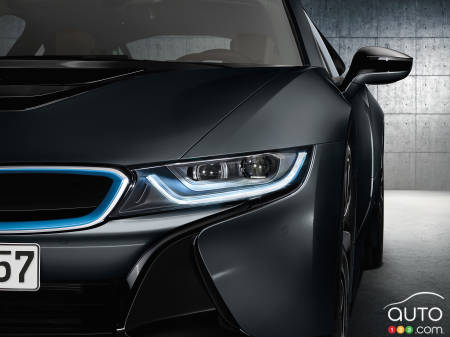In the past year, science has been pretty awesome. It revealed that there were once man-sized mega-penguins roaming the earth. It allowed humankind to land a harpoon-powered space-probe on the surface of a comet. It also taught us that dogs like to poop while aligned with the earth’s magnetic field. Who doesn’t!?
Science is advancing the automobile, too. The latest in metallurgy has allowed automakers to make more use of high-tensile steel, creating cars that are stronger and lighter. Computer science has allowed the creation of cars that can be accessed via Smartphone, cars that can tell you you’re about to whack into a piece of highway infrastructure, and even cars that can drive themselves while you take a nap or read the paper. Chemical science is creating batteries that are smaller, lighter, and more powerful than ever, too -- for better-than-ever hybrids.
That’s all neat-o stuff; but it might be lighting that’s the next big area of scientific advancement for today’s automakers. Lighting technology is advancing rapidly, and automakers are working harder than ever to bring the next big thing in automotive lighting to market.
The days of the standard halogen bulb might be numbered. Here’s a look at those once high-tech halogen bulbs, and the other technologies that’ll start replacing them.
Lighting System: Halogen
How it Works: This simple and effective lighting system works similarly to most of the light bulbs you’ll find in an older house: by using an electrical current to super-heat an element to glowing-white-hot temperatures. The bulb is filled with halogen gas, which improves its lifespan and creates a whiter and more powerful light.
Pros: Halogen bulbs are proven, inexpensive, and un-sophisticated. If you burn one out on the move, you’ll likely be able to find a replacement at the nearest gas station or convenience store.
Cons: Aside from limited light output and bulb life, halogen lighting wastes a lot of energy, since they create more heat than light. Further, they’re about as high-tech as a salad.
Neat Stuff: Within a fraction of a second after being turned on, a halogen bulb filament reaches temperatures exceeding 2,200 degrees Celsius. Hawt! Also, halogen gas reacts with the tungsten vapours ejected from the hot filament, and re-deposits them onto the filament, helping the bulb last longer. Think of it as a built-in, chemically driven recycling process.
Lighting System: Xenon
How it Works: An electric current is used to ionize xenon gas (or some blend of gases including xenon), contained within a capsule that house two electrodes. Once an electrical current ionizes the gas mixture, the light itself comes from an electric arc created as electrons flow through the ionized gas inside the capsule. By fiddling with the mix of gases inside the capsules, designers can control the color of the light output.
Xenon lights work by encapsulating the same scientific processes that create lightning within a glass capsule. That’s right: If your car has xenon lights, you can tell your buds your car uses lightning to see. Most xenon lighting systems use a projector to focus the extremely bright lighting into a pattern that won’t blind oncoming traffic.
Pros: With xenon-gas based lighting systems, less of the lighting system’s energy is used to create heat, and more is used to create actual illumination. This means that xenon lighting systems are more energy efficient, can create less heat, and offer longer service life than traditional halogen bulbs.
Cons: Xenon lighting systems costs more than halogen, may contain harmful chemicals and gases that are bad for the environment, and may take a few seconds to achieve full brightness when turned on, especially in very cold weather.
Neat Stuff: In a bi-xenon headlight setup, the same xenon lighting capsule handles both low and high-beam illumination. How? A shutter opens and closes to block some portion of the light from escaping the system for low-beam operation, and flips out of the way to un-block full lighting transmission in high-beam operation.
Lighting System: Light Emitting Diode (LED)
How it Works: An LED light has no filament, no gasses and no actual bulbs: simply, light is generated when electrons pass through a unique type of semiconductor and emit photons -- or tiny pieces of light -- in the process.
Pros: The energy draw is remarkably low for the amount of light created by LED lights. Plus, since there’s no filament to burn out and virtually no heat generated, the life-span of LED lights can be much longer than halogen or xenon. Unlike xenon lights, LED lighting doesn’t contain mercury or other metal-derived gases and vapours.
Cons: LED lighting technology is relatively expensive up front, and can be sensitive to high-temperature environments. Without very careful heat-sinking, LED lighting systems can suffer irreversible damage if used in an area with a high ambient temperature.
Neat Stuff: LED lights switch on instantly, even in extreme cold, making them ideal for headlight and brake-light applications. Since the LED light sources themselves are compact and easily designed into numerous configurations, they can be used in a wide variety of applications. In some vehicles, LED lights are employed for 100% of the illumination: from the high-beams to instrument cluster illumination to the license-plate lights.
Lighting System: Laser
How it Works: This next-generation lighting system will utilize the power of the laser to generate forward illumination. Unlike the sort of laser you use to annoy fellow moviegoers or set off a riot of fur and claws through the window of your local cat shelter, laser lights use a blue laser at their functional core -- though that’s not what you’ll see.
Blue laser beams converge via the reflecting action of mirrors onto a lens with a special coating that’s also filled with a special gas. This lens turns the high-powered laser light from blue to intense white as it passes through, and special optics and projectors control the spread and dispersion of the laser-generated light ahead of the car. Effectively, a laser lighting system takes a very thin beam of energy and turns it into an intense white light.
Pros: Next-generation laser lights are several times brighter than even an LED high-beam setup, while using as little as half the energy. Laser lights are lighter and more compact, allowing for more design flexibility, too. The colour of the light emitted closely matches that of the sun, and can be blasted very, very far up the road.
Cons: Laser lights are still too pricey to become mainstream in the immediate future, and because of archaic North American regulations regarding automotive lighting systems, and limits on maximum permissible light output in particular, we’re not likely to see them here any time soon.
Neat Stuff: In Europe, where a few models currently run laser-powered lights, regulations require various control strategies and safety systems to keep the lights in check and from harming other drivers. Intended as a sort of “super high-beam,” the laser lights are only available above a certain speed, and can’t be used to flash oncoming motorists. Audi even has a laser rear fog lamp system, which uses a laser in the rear taillamp to project a red triangle into the area behind the vehicle in inclement weather for increased safety -- though this system isn’t approved for use in North America.



